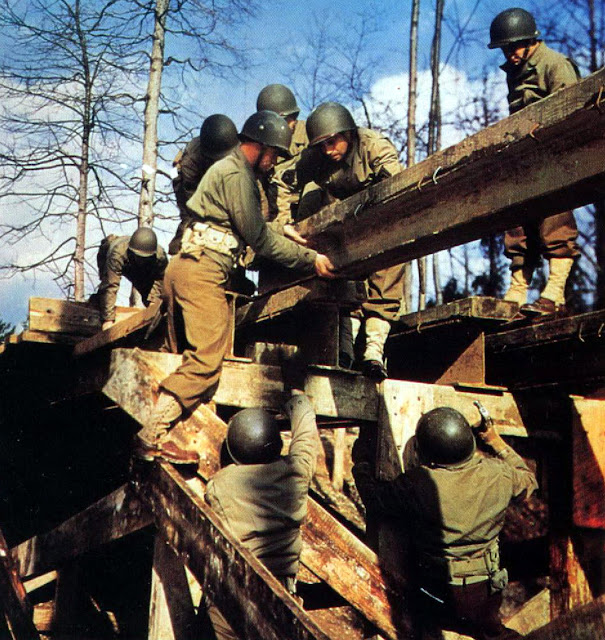Source :
https://www.facebook.com/photo/?fbid=4369889033097876&set=gm.1781015942083821
World War II, WW2, Color, Farbe, Berwarna, ORI, Original, Germany, Italy, Japan, USA, Nazi, Great Britain, France, Soviet Union, Red Army, Waffen-SS, Luftwaffe, Kriegsmarine, Soldiers, Generals, Officers, Tank, Panzer, Tiger, Panther, Sherman, Aircraft, Bomber, Messerschmitt, Spitfire, Hitler, Churchill, Stalin, Rommel, Himmler, Goering, Roosevelt, Patton, Guderian, Mustang, Zero, Admiral, Sailot, Battleship, Holocaust, Third Reich, fascist, Kaigun, Rikugun, RAF, Battle, Operation
Friday, July 16, 2021
US Army Combat Engineers Salvaging Steel
Sunday, April 4, 2021
US Army Engineers Locating Land Mines
 In Italy with US Army Engineers locating land mines, 1943. The conventional method of mine detection was developed in World War II and has changed little since then. It involves a metal detector, prodding instrument and tripwire feeler. Deminers clear an area of vegetation and then divide it into lanes. A deminer advances along a lane, swinging a metal detector close to the ground. When metal is detected, the deminer prods the object with a stick or stainless steel probe to determine whether it is a mine. If a mine is found, it must be deactivated. Although conventional demining is slow (5–150 square metres cleared per day), it is reliable, so it is still the most commonly used method. Integration with other methods such as explosive sniffing dogs can increase its reliability. Demining is a dangerous occupation. If a mine is prodded too hard or it is not detected, the deminer can suffer injury or death. The large number of false positives from metal detectors can make deminers tired and careless. According to one report, there is one such incident for every 1000–2000 mines cleared. 35 percent of the accidents occur during mine excavation and 24 percent result from missed mines.
In Italy with US Army Engineers locating land mines, 1943. The conventional method of mine detection was developed in World War II and has changed little since then. It involves a metal detector, prodding instrument and tripwire feeler. Deminers clear an area of vegetation and then divide it into lanes. A deminer advances along a lane, swinging a metal detector close to the ground. When metal is detected, the deminer prods the object with a stick or stainless steel probe to determine whether it is a mine. If a mine is found, it must be deactivated. Although conventional demining is slow (5–150 square metres cleared per day), it is reliable, so it is still the most commonly used method. Integration with other methods such as explosive sniffing dogs can increase its reliability. Demining is a dangerous occupation. If a mine is prodded too hard or it is not detected, the deminer can suffer injury or death. The large number of false positives from metal detectors can make deminers tired and careless. According to one report, there is one such incident for every 1000–2000 mines cleared. 35 percent of the accidents occur during mine excavation and 24 percent result from missed mines.Source :
https://en.wikipedia.org/wiki/Demining
https://www.facebook.com/groups/237076659811098/permalink/1707581389427277/?__cft__[0]=AZUx0dYLNfqxBviinHiydaNq6YBrrH7rLoT_T_kFp1NWHcWqAhpbo8XqhNddJcBRH_aQ1QRu51v0wj1mxeGFlEnaqOCDTV88w6CBDGee8OxMpAuF4OGOj5t-0jrrkkU9OeL2WYWXwRQ2uYYCrHgIkAZ3h-z8dVjlUxIzU2tH7ut8BkSpPNyjdX6jnJLMormFW7M&__tn__=%2CO%2CP-R
Monday, October 17, 2016
River Crossing in Russia Using a Ferry Made of Brückengerät B
Source :
Book "World War II River Assault Tactics" by Gordon L. Rottman
http://www.usmbooks.com/nazi_army_combat_print_set.html
Sunday, April 17, 2016
US Skitroopers Crossing the Engineer Wooden Bridge
Source :
Sunday, January 10, 2016
U.S. Engineer Soldiers Train on the Construction of a Pontoon Bridge
Source :
Book "Patton's Third Army" by Christopher J. Anderson
Thursday, January 7, 2016
Pioneer Training
Source :
Book "Patton's Third Army" by Christopher J. Anderson
Thursday, September 3, 2015
Oberingenieur Rudolf Blaser on the wing of a Fw 190 flown by Oberfeldwebel Walter Grünlinger
Source :
Luftwaffe im Focus Spezial No.1 2003
Wednesday, July 1, 2015
German Armour Crosses the Don River Over a Pontoon Bridge
Source :
Book "The Caucasus 1942-43; Kleist's Race for Oil" by Robert Forczyk










